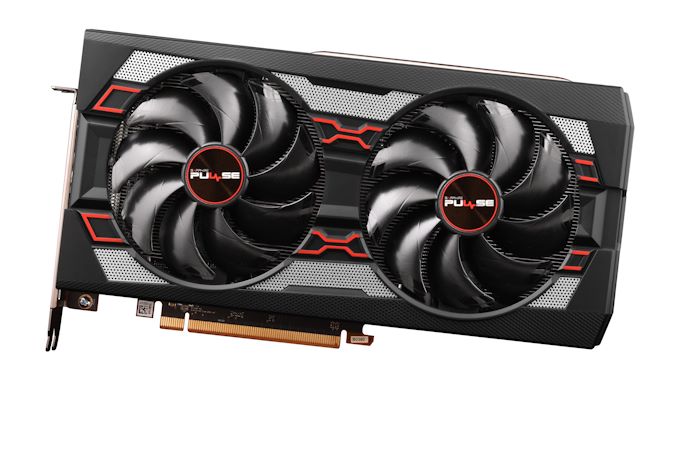
While at this point we’ve pretty much reached the “mid-generation” point in the GPU space, that doesn’t mean activity in the GPU market is slowing down. Indeed, just three weeks into 2020 and AMD is already up to bat with a new video card, the Radeon RX 5600 XT. Announced a couple of weeks back at CES 2020, the Radeon RX 5600 XT is AMD’s answer to the $200-$300 mainstream video card segment, and is designed to be their ultimate 1080p gaming card. And of all of the AMD RX 5000 series video card launches in the last six months, it’s quickly shaping up to be the biggest fight yet between AMD and NVIDIA.
The reasons for such a competitive and contested atmosphere are two-fold. First, AMD is bringing in some fairly powerful hardware to anchor their position in the sub-$300 market. Even as cut-down as it is, the Navi 10 GPU used in the RX 5600 XT is quite powerful, easily outclassing NVIDIA’s GeForce GTX 1660 series. The second factor is just how badly both AMD and NVIDIA want this market: AMD has determined that it’s essential to break into this market and to break NVIDIA’s virtual domination of the mainstream, while NVIDIA is quite happy with the status quo. As a result, over the last week alone both parties have been making moves to reposition and counter each other in an effort to come out on top, including price cuts and last-minute BIOSes. So in many ways the launch of the Radeon RX 5600 XT feels like the biggest slugfest yet between AMD and NVIDIA in quite some time.
Overall, the $279 RX 5600 XT is designed to fill that gap between the RX 5700 series and the RX 5500 series, employing a further cut-down version of AMD’s class-leading Navi 10 GPU. For their newest card, AMD is dialing back on the amount of enabled hardware in order to offer a card with performance between the existing Radeon RX 5000 series cards, and with a price to match.
| AMD Radeon RX Series Specification Comparison | ||||||
| AMD Radeon RX 5600 XT | AMD Radeon RX 5700 | AMD Radeon RX 5500 XT | AMD Radeon RX 590 | |||
| CUs | 36 (2304 SPs) |
36 (2304 SPs) |
22 (1408 SPs) |
36 (2304 SPs) |
||
| Texture Units | 144 | 144 | 88 | 144 | ||
| ROPs | 64 | 64 | 32 | 32 | ||
| Base Clock | 1247MHz? | 1465MHz | 1607MHz | 1469MHz | ||
| Game Clock | 1375MHz | 1625MHz | 1717MHz | N/A | ||
| Boost Clock | 1560MHz | 1725MHz | 1845MHz | 1545MHz | ||
| Throughput (FP32) | 7.2 TFLOPs | 7.95 TFLOPs | 5.2 TFLOPs | 7.1 TFLOPs | ||
| Memory Clock | 12 Gbps GDDR6 | 14 Gbps GDDR6 | 14 Gbps GDDR6 | 8 Gbps GDDR5 | ||
| Memory Bus Width | 192-bit | 256-bit | 128-bit | 256-bit | ||
| VRAM | 6GB | 8GB | 4GB/8GB | 8GB | ||
| Transistor Count | 10.3B | 10.3B | 6.4B | 5.7B | ||
| Typical Board Power | 150W | 180W | 130W | 225W | ||
| Manufacturing Process | TSMC 7nm | TSMC 7nm | TSMC 7nm | GloFo/Samsung 12nm | ||
| Architecture | RDNA (1) | RDNA (1) | RDNA (1) | GCN 4 | ||
| GPU | Navi 10 | Navi 10 | Navi 14 | Polaris 30 | ||
| Launch Date | 01/21/2020 | 07/07/2019 | 12/12/2019 | 11/15/2018 | ||
| Launch Price | $279 | $349 | $199/$169 | $279 | ||
As mentioned earlier, AMD hasn’t minted a new GPU for the Radeon RX 5600 XT. Instead, the company is using a further cut-down version of Navi 10, which is already used for the Radeon 5700 series. And while AMD generally avoids talking about salvaging when discussing lower-tier products, it's difficult to imagine that's not a factor here, even if the official line is focused more on it being a conscientious choice to bring Navi 10 down to compete with NVIDIA's GTX 1660 series. Either way, with the RX 5600 XT essentially getting a third-tier Navi 10-based card.
All told, it is rather rare for AMD to offer a third-tier part on the desktop; normally the company only offers two cards/configurations before moving up or down to the next GPU. Part of their current situation is based out of sheer necessity on the GPU side of matters – Navi 14 isn't powerful enough for the market AMD is chasing – though I imagine yields on the 7nm process also have room to improve since it's still relatively young. At the end of the day, it means AMD can kill two birds with one stone by putting chips that would otherwise be discarded to use in a card to counter the GeForce GTX 1660 series.
Digging into the specifications, as it’s configured, the Radeon RX 5600 XT is set to be firmly between the RX 5700 and RX 5500 XT in performance. AMD’s interesting choice of functional blocks to cut (and not to cut) means that the RX 5600 XT actually retains a lot of the RX 5700’s "core" GPU performance: on paper, the card's shading, texturing, pixel throughput, and compute performance are all quite close to the RX 5700, with the only difference is 15% lower average clockspeeds. AMD has even retained Navi 10's 64 ROPs, meaning that the card has plenty of pixel pushing power.
Instead, the big tradeoff in specing out the RX 5600 XT has been in memory bandwidth, and to a lesser extent memory capacity. The RX 5600 XT ships with 6GB of GDDR6 on a 192-bit memory bus, which is to say that 1/4 of Navi 10's MC/L2 partitions have been disabled. Furthermore the card ships with 12Gbps GDDR6 instead of the 14Gbps chips found on the RX 5700/5500. As a result, the RX 5600 XT has 36% less memory bandwidth than the RX 5700, coming in at 288GB/sec, making this the biggest factor differentiating the RX 5600 XT from its RX 5700 sibling.
The flip side of the coin, however, is that a 192-bit memory bus means that the RX 5600 XT has a lot more memory bandwidth than the RX 5500 XT, with the new card delivering 29% more memory bandwidth here. And with significantly more ROPs and CUs to feed than the RX 5500 XT, the RX 5600 XT is posed to shoot well past AMD's cheaper 1080p card.
Cutting back on memory bandwidth makes a lot of sense for AMD, both in terms of differentiating products with regards to performance as well as bringing down the card’s manufacturing price. That said, this is the first time in a long while that we’ve seen an AMD card with a 192-bit memory bus; the company normally just doesn’t do it. Power-of-two configurations are easier to deal with for various reasons, and it’s always allowed AMD to pack in more memory than NVIDIA’s competing mid-range cards. Ultimately the use of a 192-bit bus means that AMD can put to work Navi 10 GPUs with a bad memory controller, all the while using fewer (and cheaper) memory chips than in a 256-bit card. But it also means they are only able to outfit the card with 6GB of memory, as opposed to 8GB.
Without getting entirely sidetracked here, I went into this matter a bit back in the RX 5500 XT launch, but I do have some concerns about cards with less than 8GB of VRAM. With the next-gen consoles set to launch this year, the bar on hardware requirements is about to be significantly raised in one fell swoop, and I worry that sub-8GB cards won’t have enough memory capacity. With all of that said, however, whatever the ramifications are, it will mean AMD and NVIDIA are on equal footing: both the RX 5600 XT and GTX 1660 series ship with 6GB of VRAM, so both cards will thrive or falter at the same time. Clearly explaining a 6GB RX 5600 XT versus an 8GB RX 5500 XT is going to be a trickier matter for AMD's marketing department, however.
Rounding out the hardware package, AMD tells us that the new cards – or at least, those cards that meet the reference specifications and aren’t factory overclocked – will ship with a total board power (TBP) of 150 watts, which like everything else is right between the RX 5700 and RX 5500 XT. The smaller VRAM amount and lower clockspeeds help to bring down power consumption versus the RX 5700, which helps to keep AMD's energy efficiency up. In fact, AMD tells us that their 150W TBP value for the retail card is a bit on the conservative side of matters, and that real-world power usage will sometimes be less, something we’ll see in a bit more detail later on.
Product Positioning & The Competition
Since the RX 5600 XT is built from the same Navi 10 GPU as AMD’s RX 5700 cards, AMD’s board partners are hitting the ground running here in terms of board designs. Some are just outright be reusing RX 5700 designs, while others have tweaked their designs to account for the narrower memory bus, lower TBP, and lower sticker price.
This also means that this is a board partner-driven launch. AMD doesn’t have a (public) reference card, and it is the board partners shipping custom designs from day 1. As these are sub-$300 cards we won’t be seeing anything too exotic – mostly the usual variations on two and three fan designs – though it looks like factory overclocked cards will be heavily peppered into the mix.
As mentioned previously, AMD’s target market for the RX 5600 XT is mainstream gamers, with the company offering a card that is supposed to be the final word in 1080p gaming. 1080p is still the single largest segment of the gaming market, and after watching rival NVIDIA sell GTX 1060 and GTX 1660 cards by the millions over the last few years, it's a market that AMD isn't content to leave alone. Within North America and Europe, the mainstream ($200-$300) market segment is the single largest in terms of volume. And while it doesn’t come with the halo mindshare effect that the winner of the high-end market gets, AMD believes its still important for overall mindshare and market share by making the company a viable and visible competitor in this big market.
Within AMD’s product stack, the RX 5600 XT doesn’t have a particularly good direct predecessor. The closest analog would be the Radeon RX 590, which is somewhat the same lineup that the RX 5700 served to replace. However as it’s not as powerful as the RX 5700, the RX 5600 XT, there's an argument to be had about whether it delivers a “proper” generational performance update over the RX 590. Instead, this launch is defined more by the price point and the current-generation products it competes with. AMD wants the mainstream market, and the RX 5600 XT is the card that will deliver it.
Of course, NVIDIA isn’t going to surrender without a fight. Over the past couple of years they have sold GTX 1660 and GTX 1060 cards by the boatload, giving them tight control of this market segment, and they’d like to keep it. This has led to the normally conservative company making a surprising move: cutting the price on an existing card. The lowest-tier GeForce RTX card, the RTX 2060, is now starting at $299 – and far from being a one-off matter even NVIDIA’s Founders Edition card received a price cut. And while NVIDIA will downplay this a bit so that they aren’t seen as being reactionary, there are only so many ways to interpret a Founders Edition card price cut less than a week before a known AMD launch.
At any rate, AMD designed the RX 5600 XT to beat the GTX 1660, and as we’ll see, this is a battle it handily wins. So NVIDIA has made the most logical move on their part and brought in a more powerful card to compete.
What we end up with then is a calculus of performance and prices, with each GPU marker trying to one-up the other without compromising on pricing by too much. At $299 the RTX 2060 isn’t a perfect competitor to the RX 5600 XT, but then again it’s a bit faster. Meanwhile the $279 RX 5600 clobbers the $279 GeForce GTX 1660 Ti, which is what AMD wanted all along. But the GTX 1660 Ti itself has been a dead card walking for the last three months as far as value goes; NVIDIA’s best option here is the $229 GeForce GTX 1660 Super, which delivers most of the Ti’s performance for a lot less.
So for better or worse, there are no head-to-head matchups to speak of today. Instead, everyone is banking on price tiers and total value. This means that the big challenge for AMD isn't even raw performance, but rather it's all about beating NVIDIA on overall value. Radeon RX 5600 XT needs to be fast enough to justify its price premium over the GTX 1660 Ti, and close enough to the RTX 2060 to overcome the kind of interia that has helped NVIDIA rule the mainstream market for the last three years. As we’ll see, AMD can do it, but this is a game of inches and cents.
Finally, like virtually all of AMD’s other products launched in the last six months, the new RX 5600 XT will also qualify for AMD and Microsoft’s ongoing Xbox Games Pass offer. So video card buyers will get a 3 month free trial to Microsoft’s games subscription program.
| Q1 2020 GPU Pricing Comparison | |||||
| AMD | Price | NVIDIA | |||
| Radeon RX 5700 | $329 | ||||
| $299 | GeForce RTX 2060 | ||||
| Radeon RX 5600 XT | $279 | GeForce GTX 1660 Ti | |||
| $229 | GeForce GTX 1660 Super | ||||
| Radeon RX 5500 XT 8GB | $199/$209 | GeForce GTX 1660 | |||
| Radeon RX 5500 XT 4GB | $169/$159 | GeForce GTX 1650 Super | |||
| $149 | GeForce GTX 1650 | ||||
As I mentioned earlier, the launch of the Radeon RX 5600 XT is turning into quite a competitive event between AMD and NVIDIA. After initially announcing the card two weeks ago, we’ve seen NVIDIA start to cut prices on the RTX 2060. And that seemingly has elicited a reaction-reaction from AMD as well.
Midday Wednesday, less than a day after AMD made the drivers available to the press, the company sent word that they would be sending out new BIOSes for the cards they had sampled, Sapphire’s Pulse Radeon RX 5600 XT. And sure enough, on Thursday morning new BIOSes arrived, which had a rather material impact on testing results.
I’ll get to the content of the BIOSes themselves in a second, but even before we go that far, I want to note how unusual it is to receive last-minute BIOS changes. For brand-new architecture launches this isn’t unheard of, especially to fix last-minute bugs. But for GPUs that have been out for months – and for cards that are already on the way to retailers – last minute BIOSes are almost never necessary. So when it does happen, it generally means that a vendor is making some last-minute adjustments for competitive reasons, and that’s exactly what’s happening here.
All told, AMD and Sapphire’s last-minute BIOS adjustments seem to have done two things to Sapphire’s card.
- Further extended the voltage/frequency curve from 1630MHz to 1760MHz
- Increased the memory clock on the factory overclocked mode from 12Gbps to 14Gbps
Indeed, if we take a look at the voltage-frequency curves on the Pulse RX 5600 XT’s quiet mode BIOS, we see the following.
While the display in AMD’s drivers is a bit rough, we can clearly see that AMD/Sapphire has extended the curve, allowing the card to boost to higher clockspeeds at a higher voltage. And the situation is pretty much the same for the performance BIOS as well, with a similar extension of the voltage-frequency curve.
Reference Clocked-Cards
Now, to be sure, AMD has not changed the reference specifications for the Radeon RX 5600 XT. So despite what’s going on, the baseline hasn’t changed. Case in point: the Pulse 5600 XT’s quiet mode BIOS has the same 135W TGP (~150W TBP) power limit both with the old and new BIOS, as well as the same 1460MHz rated game clock. And indeed, adding a bit more to the end of the voltage frequency curve generally doesn’t do much for the card, as higher frequencies are quite expensive from a power standpoint, and the card is generally bottlenecked elsewhere.
Furthermore it’s not clear right now whether similar BIOS updates are going to be issued for lower-end cards. The Sapphire Pulse is a (or at least was a) mildly factory overclocked card, with overbuilt cooling and power delivery. So AMD and its partners may not even want to issue a BIOS update to baseline models, where power and thermals would be more restricted.
That said, this entire update situation gives me the distinct impression that AMD’s plans for the RX 5600 XT changed in the last two weeks. The company was seemingly originally intending on giving the card a relatively low frequency cap, which would improve overall energy efficiency by lowering average power consumption, (still) easily beat the GTX 1660 series, and keep the RX 5600 XT from encroaching on the RX 5700. Instead, the frequency cap has been lifted, which gives the quiet-mode Pulse RX 5600 XT the slightest of performance bumps.
Factory Overclocked Cards
Unlike quiet mode, however, AMD and Sapphire’s BIOS changes are far more significant for the card’s performance mode, which is its default and full factory overclocked mode. Not only has the updated BIOS extended the frequency cap, but it has also increased the card’s power limits, leading to Sapphire adjusting the rated game clock from 1560MHz to 1650MHz. Finally, as the GPU clockspeed improvements on their own aren’t especially potent, the companies have raised the raised the memory clock as well. As a result, the Sapphire Pulse RX 5600 XT is a good bit faster now than it was 5 days ago.
| Sapphire Pulse Radeon RX 5600 XT BIOSes | ||||||
| Shipping Performance BIOS | Updated Performance BIOS | Shipping Quiet BIOS | Updated Quiet BIOS | |||
| Base Clock | 1235MHz? | 1290MHz | 1235MHz? | 1290MHz | ||
| Game Clock | 1375MHz | 1615MHz | 1460MHz | 1460MHz | ||
| Boost Clock | 1560MHz | 1750MHz | 1620MHz | 1620MHz | ||
| Memory Clock | 12Gbps GDDR6 | 14Gbps GDDR6 | 12Gbps GDDR6 | 12Gbps GDDR6 | ||
| TBP | ~160W | ~180W | ~150W | ~180W | ||
| GPU Power Limit (TGP) | 140W | 160W | 135W | 135W | ||
As a quick reminder, AMD tends to throw around both Total Board Power and Total Graphics Power. The latter is the value reported by their drivers and only measures the GPU power. TBP includes the memory and everything else
As a factory overclocked card, the Pulse 5600 XT was already shipping with a slightly goosed clockspeed and TBP, making it a 160W card in its default performance mode. The new BIOS has pushed that further north, giving it a TBP of around 180W, or around the same TBP has the Radeon 5700.
More significant than that, however, is that AMD and Sapphire have also increased the memory clock from 12Gbps to 14Gbps. This is very important, because by its very design, the RX 5600 XT’s biggest bottleneck is memory bandwidth – it has the RX 5700’s GPU throughput, but ~35% less bandwidth – meaning that increasing the memory clock delivers a major boost to the RX 5600 XT’s performance.
Case in point, here are benchmark numbers for the Sapphire card clocked at AMD’s reference clocks, AMD’s reference clocks with a 14Gbps memory clock, and finally with Sapphire’s full factory overclock.

The bulk of the performance uplift we see comes from the memory clock increases, not the power limit + clockspeed increases. This underscores the importance of memory bandwidth to this part, and furthermore the significance of this last-minute BIOS change.
The net impact of this change is that the performance delta between a reference-clocked RX 5600 XT and the factory overclocked cards that AMD is sampling to the press is quite significant. In its full factory overclocked mode, the Pulse RX 5600 XT ends up being 8% faster than a reference clocked card, which is far from the largest factory overclocks we’ve ever seen, but larger than the kind of modest overclocks that Pulse cards normally see. It’s also not too far away from the kind of performance delta that separates entire tiers of cards; if it were a 10% boost AMD could call it an RX 5600 XTX and it would fit right in to normal video card product stacks.
Rationale & Results
The big question, of course, is why AMD and Sapphire decided to make such a last-minute change. To answer that, I’ll start with AMD’s official line:
Based on ongoing testing with our board partners, we have raised the GPU core and memory frequencies for overclocked Radeon RX 5600 XT SKUs to take advantage of increased thermal and electrical headroom built into partner’s custom designs. The updated VBIOS has been made available to our board partners for inclusion in select OC SKUs at launch. AMD is dedicated to disrupting the market with industry-leading compute products, and the new VBIOS makes the Radeon RX 5600 XT an even more powerful contender for high-performance 1080p gaming. Previously announced product specs are unchanged, as they remain AMD’s recommended reference design specs.
Meanwhile, I suspect AMD’s motive may be a bit more straightforward: beating the now-$299 RTX 2060. As it so happens, the factory overclocked Sapphire Pulse RX 5600 XT pulls ahead of NVIDIA’s reference RTX 2060 by 2% – which is essentially a wash in benchmark terms – but it allows AMD and its board partners to weave RTX 2060 performance into their product messaging. If AMD can position the RX 5600 XT as an RTX 2060 competitor rather than a GTX 1660 Ti competitor, then it’s all the better for them.
Ultimately, whatever AMD’s original plans might have been, it looks like AMD’s new plan is to take advantage of partners overbuilding some of their RX 5600 XT SKUs. Case in point, if a factory overclocked card ships with 14Gbps memory and the VRMs necessary to do a TBP of 180W – say, if it’s reusing a Radeon 5700 design – then AMD and the partners have gone ahead and adjusted their cards to get more performance. To reiterate, these are factory overclocked cards that are not representative of baseline performance. And at least in the case of Sapphire’s card, these overclocked cards carry a price premium. But it creates a bit of a two-tier situation, with 12Gbps reference cards delivering a certain level of performance, and 14Gbps factory overclocked cards delivering a decent bit more.
Meanwhile, although Bill of Material (BOM) costs are a matter for the board partners rather than something for consumers to be concerned about, I suspect these factory overclocked SKUs are going to wipe out most of the BOM gains from the RX 5600 XT SKU. 14Gbps memory, better PCBs, higher capacity VRMs, and better cooling all run counter to the cost-cutting that the RX 5600 XT would otherwise allow. And as we’ll see in our benchmark results, it also wipes out most of the energy efficiency gains. So AMD is once more trading off higher power consumption for better overall performance.
All told, it reminds me a bit of the Radeon R9 290 and the GTX 460; both cards used last minute tweaks and factory overclocks to try to close a performance gap with the next tier. These kinds of actions certainly make a mess of consumer messaging, but as we’ve seen before, they can be quite effective in very close fights.
Shifting gears, let’s talk about the actual hardware that will be hitting retail shelves today. As I mentioned towards the start of the article, AMD isn’t launching an official reference RX 5600 XT, so today’s launch is all about partner cards. To that end, AMD has sampled us with Sapphire’s Pulse RX 5500 XT. Sapphire’s card is a moderately factory overclocked card, and following AMD’s BIOS changes, is apparently a good example of what AMD wants other partner factory overclocked cards to be like.
| Radeon RX 5600 XT Card Comparison | |||||
| Radeon RX 5600 XT (Reference Specification) |
Sapphire Pulse RX 5600 XT (Quiet Mode) |
Sapphire Pulse RX 5500 XT (Default/Perf Mode) |
|||
| Base Clock | 1290MHz? | 1290MHz | 1290MHz | ||
| Game Clock | 1375MHz | 1460MHz | 1615MHz | ||
| Boost Clock | 1560MHz | 1620MHz | 1750MHz | ||
| Memory Clock | 12Gbps GDDR6 | 12Gbps GDDR6 | 14Gbps GDDR6 | ||
| VRAM | 6GB | 6GB | 6GB | ||
| TBP | 150W | ~150W | ~180W | ||
| GPU Power Limit (TGP) | N/A | 135W | 160W | ||
| Length | N/A | 10-inches | |||
| Width | N/A | 2.3-Slot | |||
| Cooler Type | N/A | Open Air, Dual Fan | |||
| Price | $279 | $289 | |||
Editor's Note: These are the specs post-BIOS update. Anyone buying the Pulse in January will want to make sure to update their card with Sapphire’s new BIOSes
Sapphire has several sub-brands of cards, including the Nitro and the Pulse. Normally the Nitro cards are their higher-priced factory overclocked cards, while the Pulse cards are more straightforward. But following AMD’s BIOS changes, that seems to have at least partially gone out the window. In any case, even with its factory overclock the Sapphire Pulse RX 5600 XT is not being positioned as a high-end card among RX 5600 XTs; at $289, it carries just a $10 premium over AMD’s MSRP.
For their Pulse RX 5600 XT cards, Sapphire has opted to factory overclock both modes for the card. The card’s default mode, which is its performance mode, ships with a ~180W TBP. This affords a rather sizable 240MHz (17%) increase in the card’s rated game clock. Meanwhile the memory clock has been increased by 2Gbps (17%) to 14Gbps. In short, in performance mode the Pulse is noticeably more powerful (and power-hungry) than a baseline RX 5600 XT.
On the flip side of the coin is the card’s quiet mode BIOS. This BIOS uses settings much closer to AMD’s own reference specs, with the 150W TBP and 12Gbps matching AMD’s. The only change here is that the card gets a milder 85MHz (6%) factory overclock, as far as the game clock is concerned.
Digging into the card, it’s clear from the start that Sapphire has overbuilt the card, particularly for cooling performance. At 10-inches long the card isn’t especially lengthy, but Sapphire makes up for that with a 2.3-slot wide cooler design and significantly taller (5.3-inch) frame. Comparing it to NVIDIA’s relatively compact dual-fan GeForce RTX 2060 Founders Edition, the Sapphire Pulse RX 5660 XT has about 50% more volume. Which, along with making the card a bit of a pain to install, affords it a lot more volume for heatsinks and fans.
The payoff for this oversized design is that Sapphire can use larger, lower RPM fans to minimize the fan noise. The Pulse 5600 XT packs 2 95mm fans, which in our testing never got past 1150 RPM. And even then, the card supports zero fan speed idle, so the fans aren’t even on until the card is running a real workload and starts warming up. The net result is that the already very quiet card is completely silent when it’s idling.
Meanwhile beneath the fans is a similarly oversized heatsink, which runs basically the entire length and most of the height of the board. A trio of heatpipes runs from the core to various points on the heatsink, helping to draw heat away from the GPU and thermal pad-attached GDDR6 memory. The fins are arranged horizontally, so the card tends to push air out via its I/O bracket as well as towards the front of a system. The card also comes with a metal backplate – no doubt needed to hold the oversized cooler together – with some venting that allows air to flow through the heatsink and out the back of the card.
Feeding the beast is an 8-pin external PCIe power cable, as well as PCIe slot power for its electricity needs. From a practical perspective this is well-provisioned for a card that will hit 180W, and with the design presumably being recycled from a 5700 series design, there’s room for a second power connector if Sapphire ever needed it.
Finally for hardware features, for display I/O we’re looking at a pretty typical quad port setup. Sapphire has equipped the card with 3x DisplayPort 1.4 outputs, as well as an HDMI 2.0b output. With daisy chaining or MST splitters, it’s possible to drive up to 6 monitors from the card.
As is usually the case for launches without reference hardware, we’ve had to dial down our Sapphire cards slightly to meet AMD’s reference specifications. In this case, Sapphire’s secondary (quiet) BIOS offers reference power and memory settings, so for our reference-spec testing, we’re using that BIOS, with the GPU underclocked by 85Mhz to meet AMD’s official specs.
Finally, as the RX 5600 series is focused on 1080p gaming, this is what our benchmark results will focus on. Though I have also tested the card at our 1440p settings to see just how well it might do as a 1440p card – the lack of VRAM admittedly not doing it any big favors there – and these are posted below our 1080p results.
Finally, we’re using the latest drivers from AMD and NVIDIA.
| CPU: | Intel Core i9-9900K @ 5.0GHz |
| Motherboard: | ASRock Z390 Taichi |
| Power Supply: | Corsair AX1200i |
| Hard Disk: | Phison E12 PCIe NVMe SSD (960GB) |
| Memory: | G.Skill Trident Z RGB DDR4-3600 2 x 16GB (17-18-18-38) |
| Case: | NZXT Phantom 630 Windowed Edition |
| Monitor: | Asus PQ321 |
| Video Cards: | AMD Radeon RX 5700 Sapphire Pulse Radeon RX 5600 XT AMD Radeon RX 5500 XT 8GB AMD Radeon RX 590 AMD Radeon RX 580 AMD Radeon R9 390X NVIDIA GeForce RTX 2060 Super NVIDIA GeForce GTX 1660 Ti NVIDIA GeForce GTX 1660 Super NVIDIA GeForce GTX 1070 NVIDIA GeForce GTX 1060 6GB |
| Video Drivers: | NVIDIA Release 441.87 AMD Radeon Software Adrenalin 2020 Edition 20.1.1 |
| OS: | Windows 10 Pro (1903) |
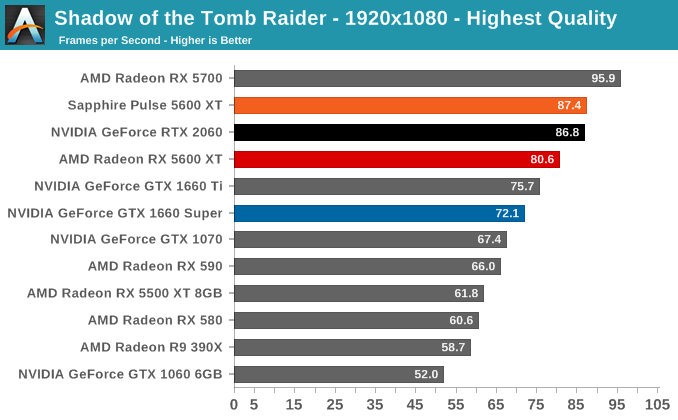
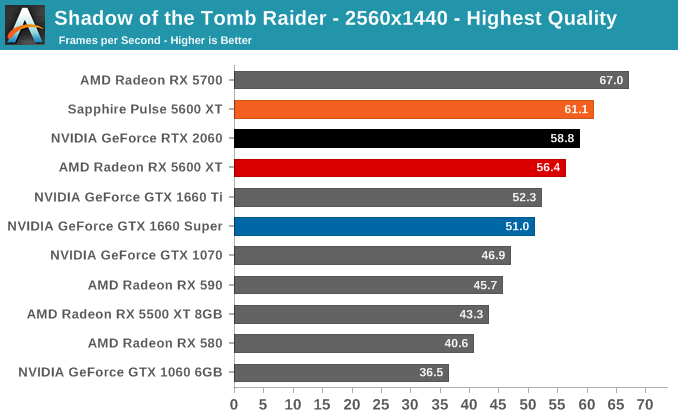
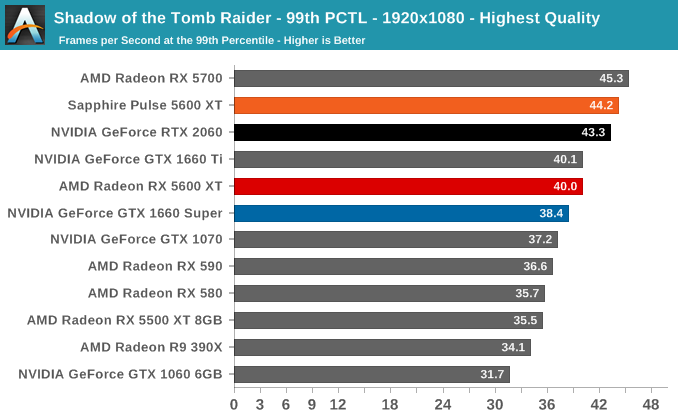

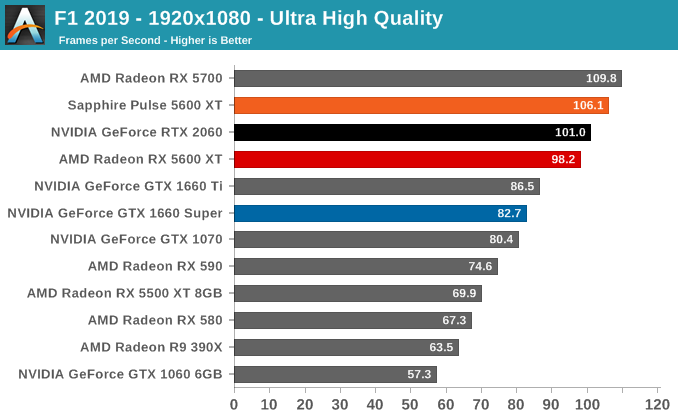

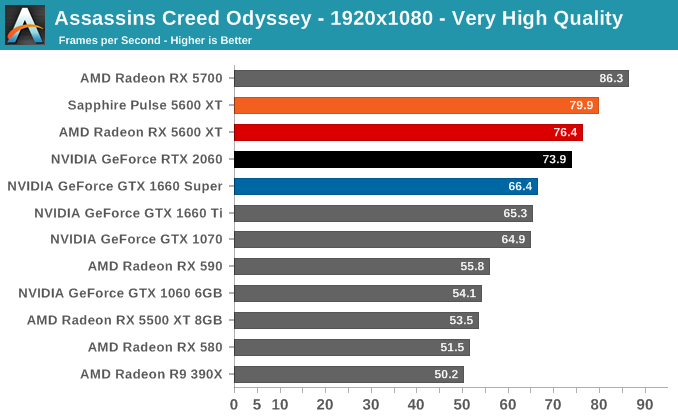
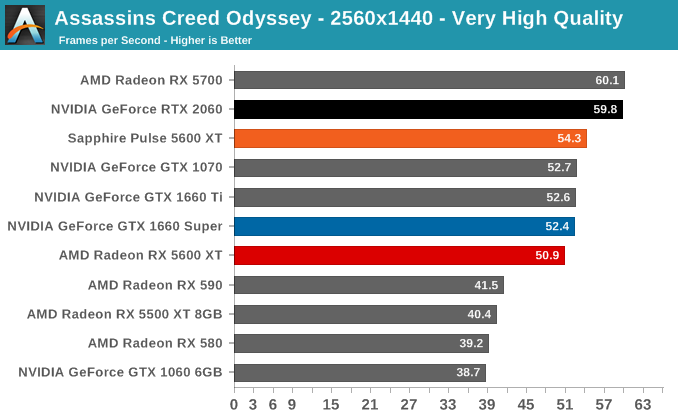
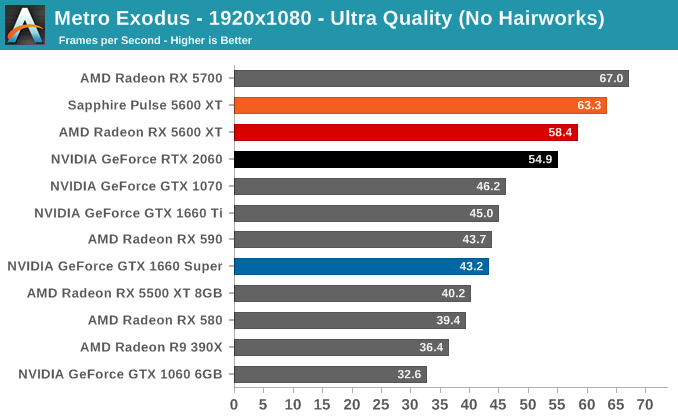
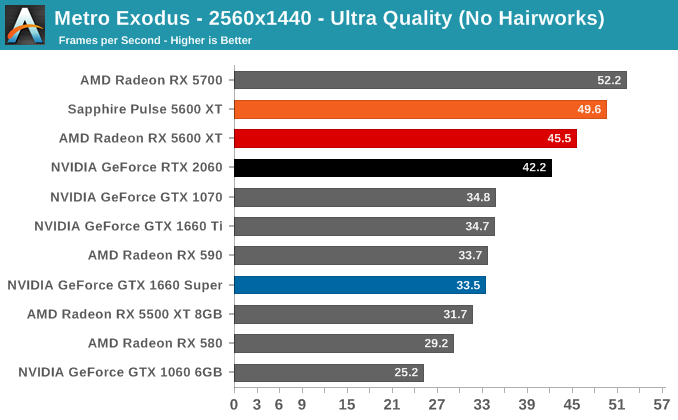
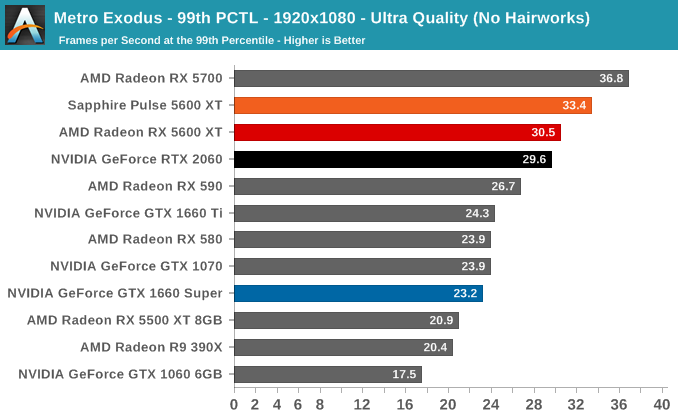
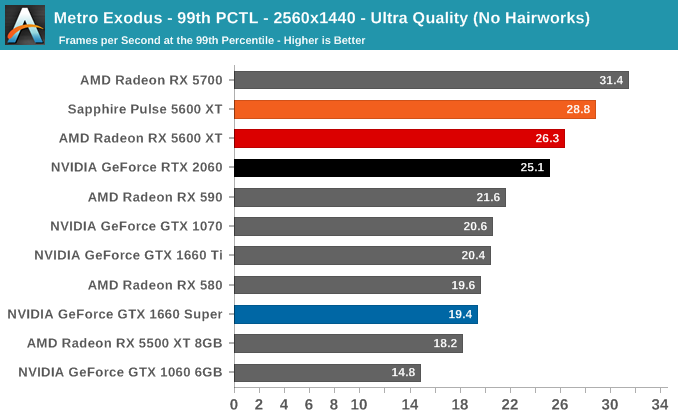

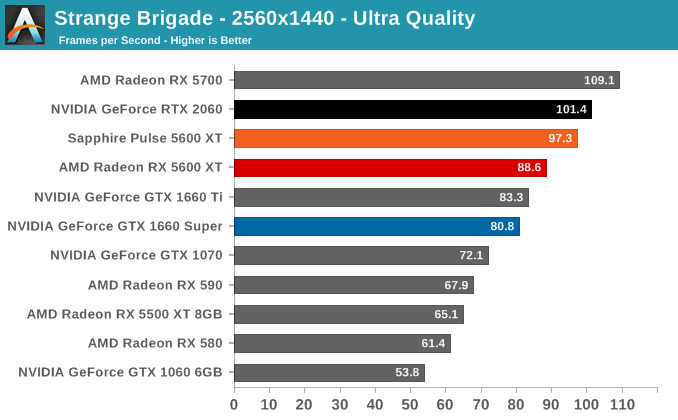
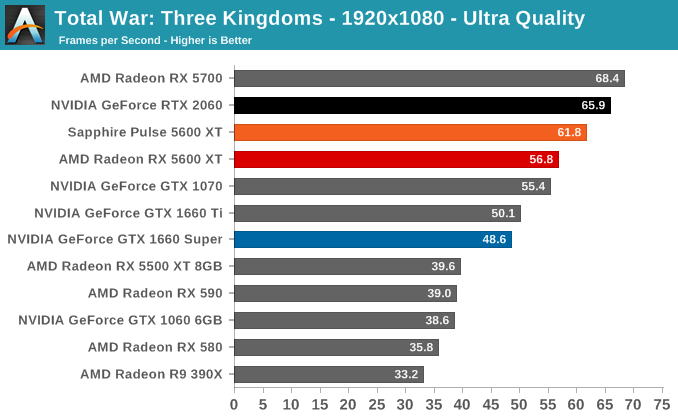
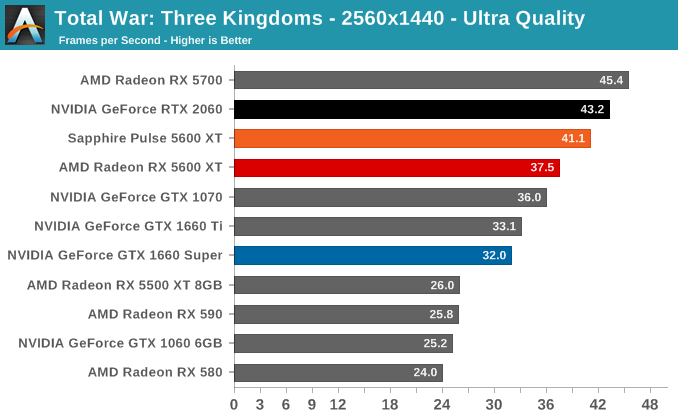
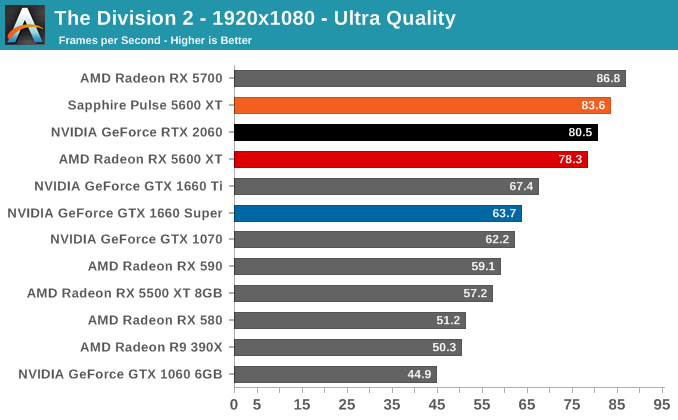
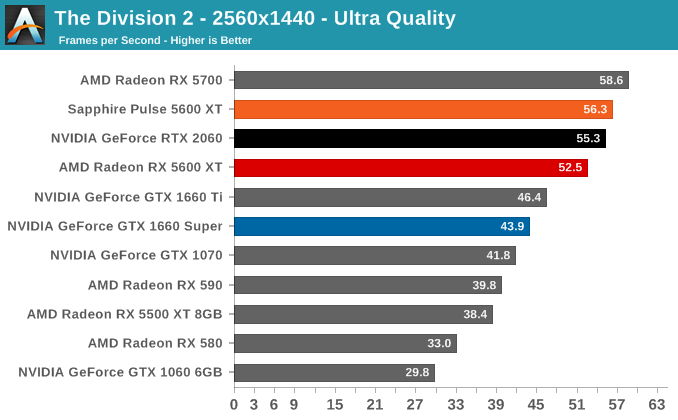
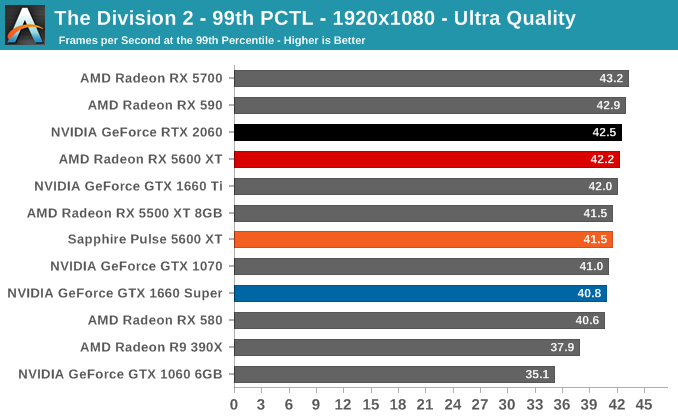
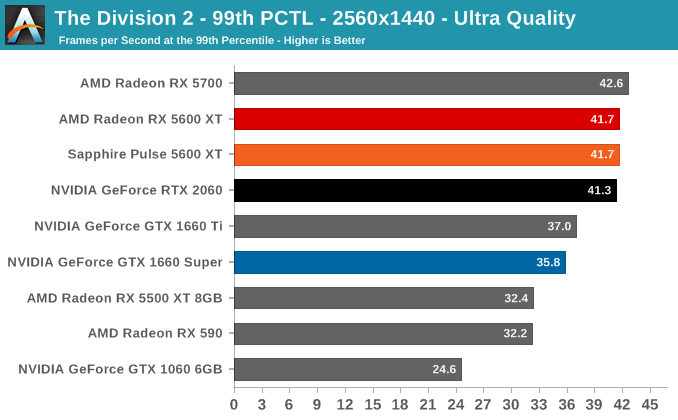
Now a truly venerable title, GTA V is a veteran of past game suites that is still graphically demanding as they come. As an older DX11 title, it provides a glimpse into the graphically intensive games of yesteryear that don't incorporate the latest features. Originally released for consoles in 2013, the PC port came with a slew of graphical enhancements and options. Just as importantly, GTA V includes a rather intensive and informative built-in benchmark, somewhat uncommon in open-world games.
The settings are identical to its previous appearances, which are custom as GTA V does not have presets. To recap, a "Very High" quality is used, where all primary graphics settings turned up to their highest setting, except grass, which is at its own very high setting. Meanwhile 4x MSAA is enabled for direct views and reflections. This setting also involves turning on some of the advanced rendering features - the game's long shadows, high resolution shadows, and high definition flight streaming - but not increasing the view distance any further.
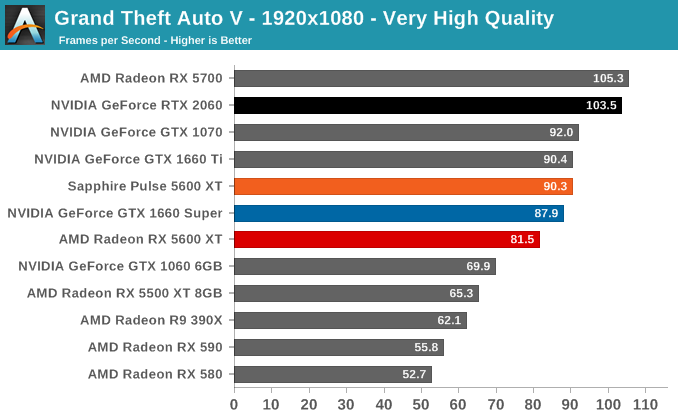
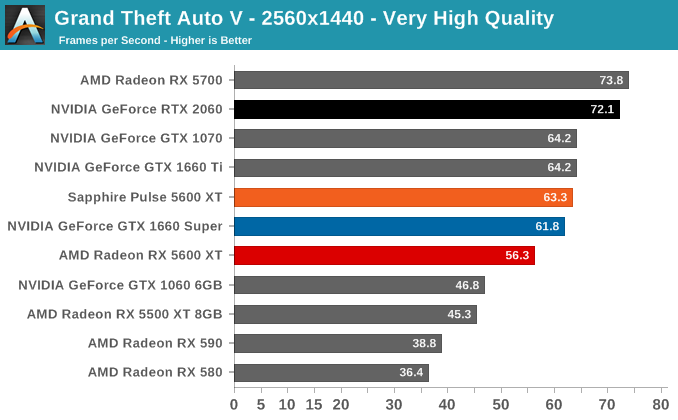
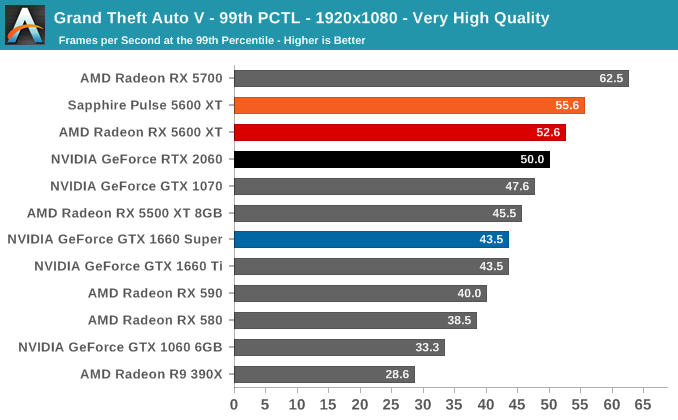

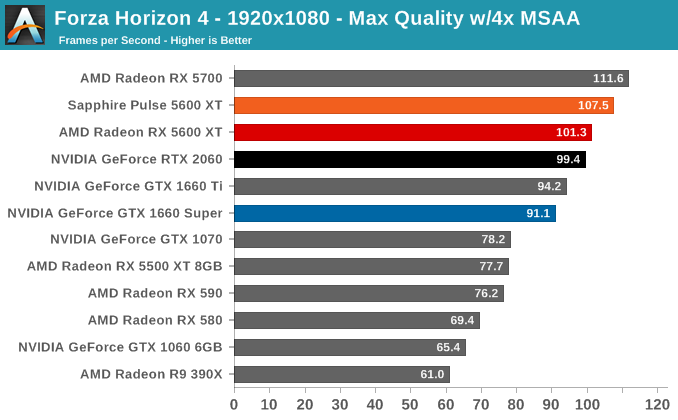
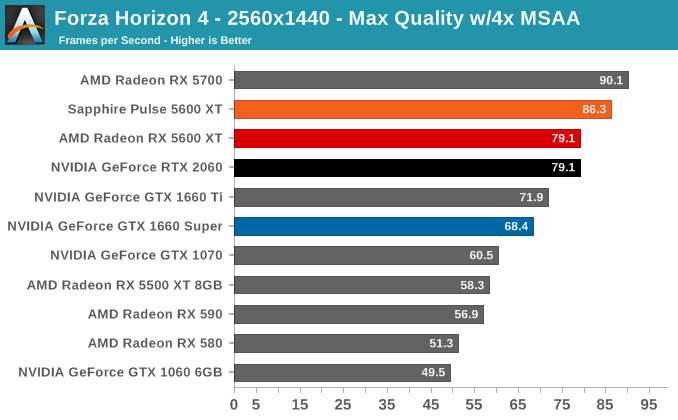
While I’m including compute performance for the sake of completeness here, the compute situation on Navi has not substantially changed since the launch of the Radeon RX 5700 series over 5 months ago. AMD’s Adrenaline 2020 software has improved the state of their OpenCL drivers slightly – there are fewer hard crashes and performance is up in some cases – but their drivers are still dysfunctional and not fit for production use. In particular, Folding@Home and parts of CompuBench are still unable to run (and SETI@Home users will want to stay clear too).
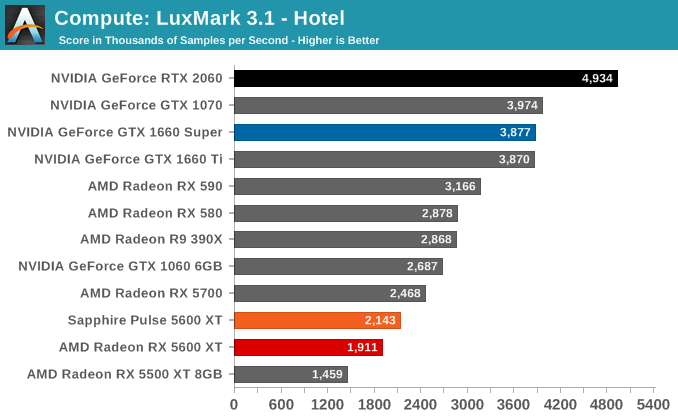
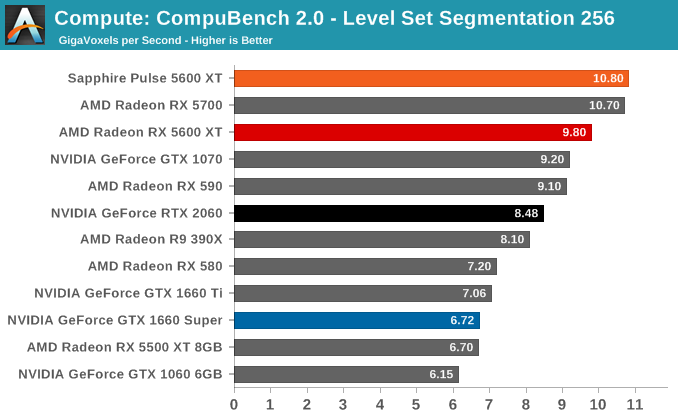
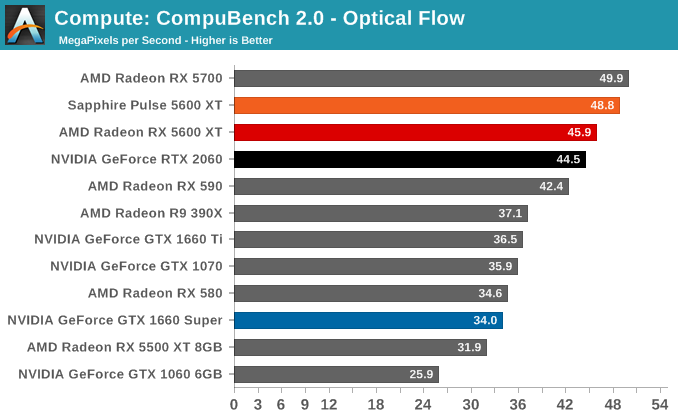
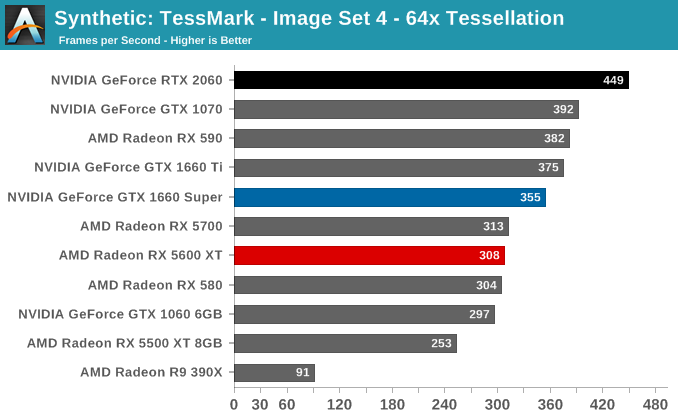
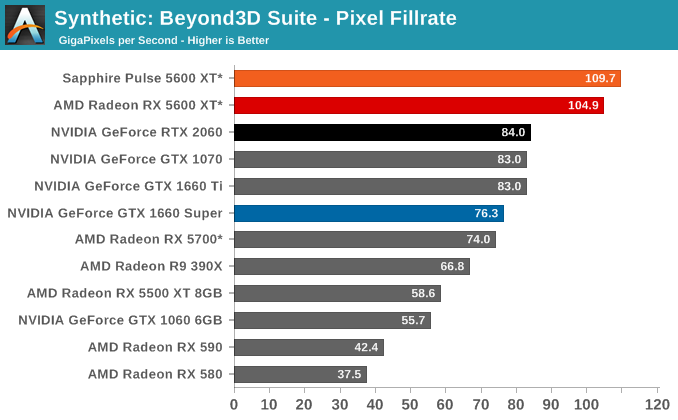

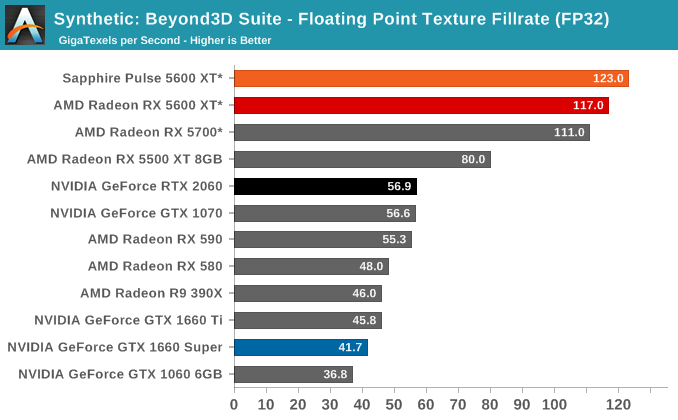
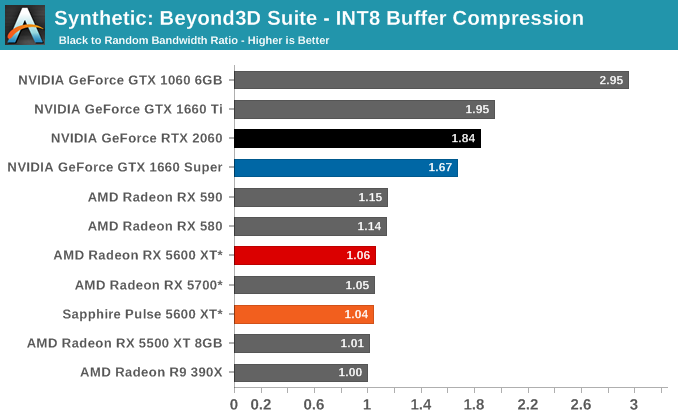
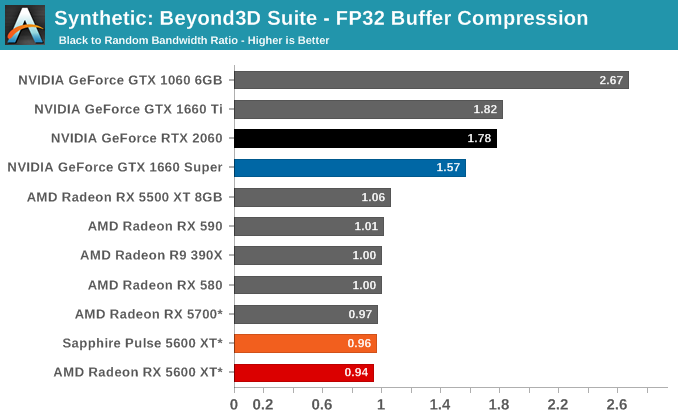
Last, but not least of course, is our look at power, temperatures, and noise levels. While a high performing card is good in its own right, an excellent card can deliver great performance while also keeping power consumption and the resulting noise levels in check.
| Radeon Video Card Voltages | |||||
| 5600 XT Max | 5700 Max | 5600 XT Idle | 5700 Idle | ||
| 0.977v | 1.025v | 0.775v | 0.775v | ||
Interestingly, even with the BIOS update and AMD’s voltage-frequency curve extension, the voltages being used by our Sapphire Radeon RX 5600 XT are quite tame. The card never goes higher than 0.977v, which is almost 0.05v lower than the Radeon RX 5700, itself already a good deal lower than the full-fat Navi 10-based Radeon RX 5700 XT. While third-tier cards like the RX 5600 XT are uncommon, when we do see them they are normally running higher voltage (leakier) parts, and this is what I was expecting for AMD’s new part.
No wonder AMD is talking up the power efficiency of the card; even with its restricted clockspeeds, not going above 1.0v helps to ensure that power efficiency doesn’t take a dive by paying a massive power penalty to access the last few MHz worth of headroom.
| Radeon Video Card Average Clockspeeds (Rounded to the Nearest 10MHz) |
||||
| Game | Sapphire 5600 XT (Perf) | 5600 XT | 5700 | |
| Max Boost Clock | 1760MHz | 1670MHz | 1750MHz | |
| Official Game Clock | 1615MHz | 1375MHz | 1625MHz | |
| Tomb Raider | 1700MHz | 1610MHz | 1680MHz | |
| F1 2019 | 1700MHz | 1610MHz | 1650MHz | |
| Assassin's Creed | 1700MHz | 1660MHz | 1700MHz | |
| Metro Exodus | 1700MHz | 1600MHz | 1640MHz | |
| Strange Brigade | 1740MHz | 1660MHz | 1660MHz | |
| Total War: TK | 1740MHz | 1660MHz | 1690MHz | |
| The Division 2 | 1700MHz | 1610MHz | 1630MHz | |
| Grand Theft Auto V | 1720MHz | 1640MHz | 1690MHz | |
| Forza Horizon 4 | 1730MHz | 1650MHz | 1700MHz | |
Shifting over to clockspeeds, things look very good for the RX 5600 XT. The card’s clockspeeds are remarkably consistent, and this comes down to the fact that the card is rarely ever entirely power-bound. Rather, the card is running out of room on the voltage-frequency curve, making it very easy to get close to its peak clockspeeds in the process. This goes hand-in-hand with the relatively low voltage, allowing the card to run rather efficiently and avoid heavier power throttling.
Unaspiringly, the card is closer to its peak when running at AMD’s reference clockspeeds than it is the default factory overclocked mode. Still, the latter sees the card average clockspeeds higher than the RX 5700, underscoring how these factory overclocked cards are primed to hit high clockspeeds, and that it’s going to be the lack of memory bandwidth that ultimately keeps them chasing the RX 5700.

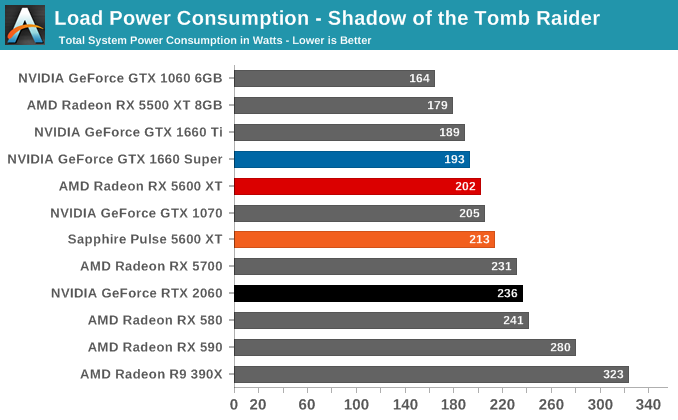
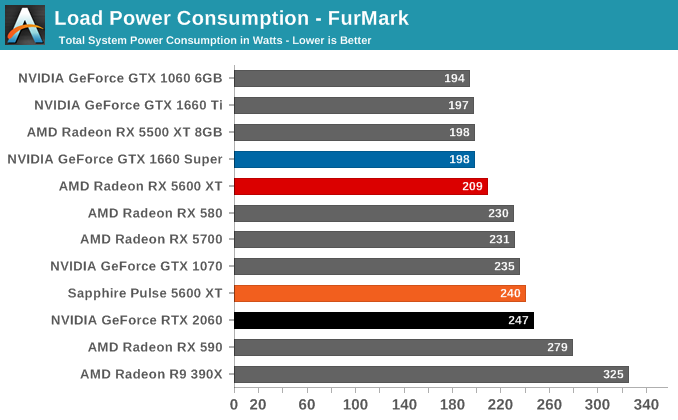
Taking a look at power consumption, we again find a good showing from Sapphire and AMD. The card’s idle power consumption shaves off a couple of watts at the wall relative to the RX 5700, thanks to the lower amount of VRAM and fully idled fans.
Meanwhile load power consumption also fares comparatively well. At reference clocks, we see AMD’s claims of higher power efficiency first-hand; measured at the wall, the card draws around 30W less than the RX 5700. Equally important, this keeps it relatively close to the GeForce GTX 1660 series. And while the RX 5600 XT ultimately ends up drawing more power, as we’ve seen it also handily outperforms those cards.
Sapphire factory overclock, however, is both a curse and a blessing. The blessing is that it improves the card’s performance to RTX 2060-levels, but the curse is that it does so while pushing power consumption to near RX 5700-levels. So when running at full tilt, the Pulse RX 5600 XT is less power efficient than the RX 5700, owing to its overall lower performance. Then again, it’s not like NVIDIA was doing very well to begin with. As a result, even when factory overclocked, the Pulse ends up drawing a bit less power than the nearest NVIDIA card.
I will also quickly note that the delta in power consumption between FurMark and Tomb Raider is higher for the RX 5600 XT than we’ve seen it in other Navi cards. All told, even at 1440p with the highest available settings, Tomb Raider is having a hard time keeping the RX 5600 XT busy enough that the card is running at maximum clockspeeds. This has made Tomb Raider turn into something of a best case scenario, as the card gets to idle a little bit.
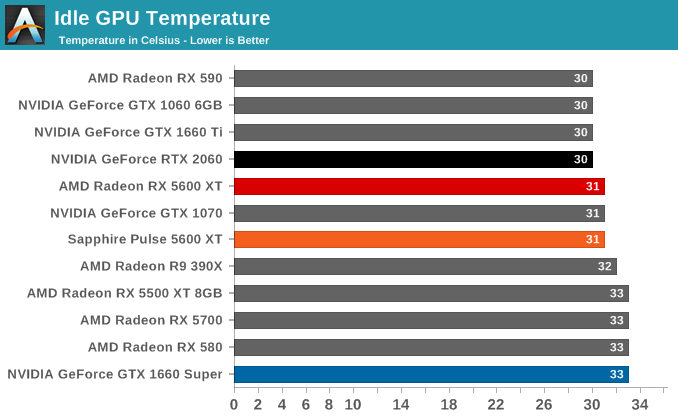
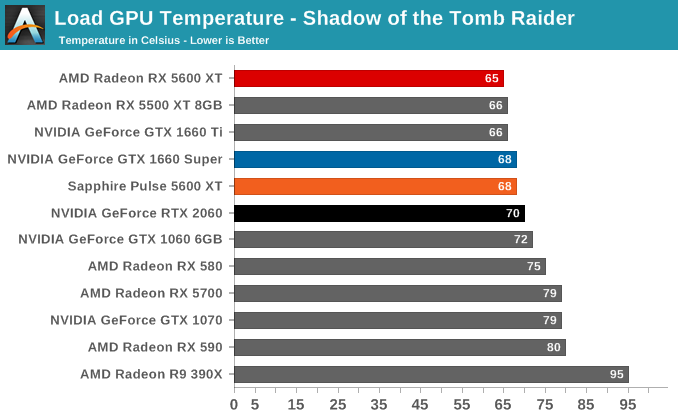

Moving on to temperatures, the large card has no problem cooling itself. In quiet mode the card never passes 68C, and even in full-on performance mode, the temperature maxes out at 74C. From a temperature perspective, Sapphire seems to have just about perfectly tuned the card’s cooler.
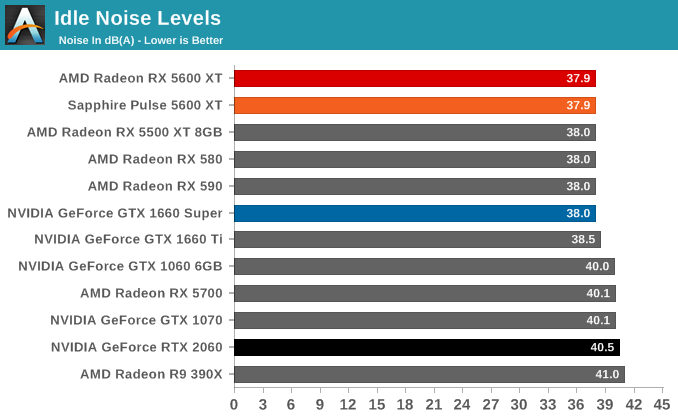
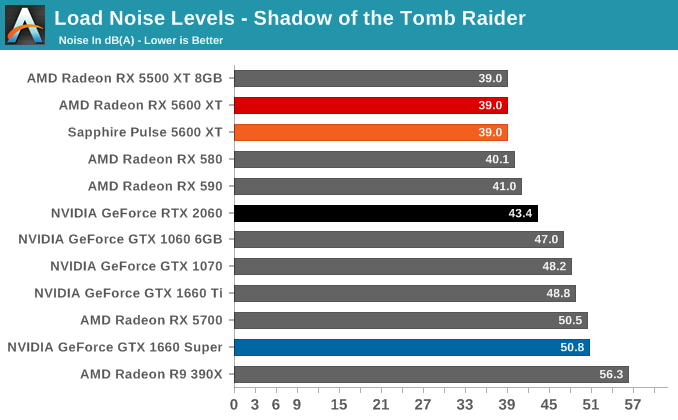

Finally, with noise, we get a chance to see how quietly the oversized Pulse can operate. And the answer is “very quietly”. At idle the card is entirely silent, thanks to its zero fan speed idle mode. Meanwhile with the quiet mode BIOS clocked at AMD’s reference clockspeeds, the fans only have to go to the card’s bare minimum fan speed – 25 percent – to keep the card cool, even under FurMark. To put this in context, we’re looking at a 150W card that’s having all of its cooling needs being met by a pair of fans running at a mere 750 RPM, which is a fraction of what they can actually run at.
Even with the factory overclock active, the cooler has no problem keeping up. Load noise for the 180W mode peaks at 41.2dB(A), which is close to silent and a great result overall. So for as much ribbing as I give Sapphire for the somewhat absurd size of the card, there’s no arguing with the effectiveness of the cooler. It’s quitter than almost every other card in this chart, including the GeForce GTX 1660 series cards and NVIDIA’s own reference RTX 2060.
Bringing a close to our first video card review of the year, and it’s easy to see how it’s already setting a high-water mark in terms of competitiveness. While AMD’s new Radeon RX 5600 XT doesn’t bring anything new to the table in terms of performance for AMD, the card is primed to crack open the sub-$300 market for mainstream video cards. And in the process, force both AMD and NVIDIA to realign their video card lineups to provide a better value.
On the whole, AMD set out to deliver what they thought would be the ultimate 1080p gaming card, and the Radeon RX 5600 XT certainly lives up to that claim. While the categorization is somewhat arbitrary – AMD could have instead pitched it as a weaker-but-cheaper 1440p card – it puts the card in a very good frame of reference. The RX 5600 XT is fast enough to average more than 60fps at 1080p in all but one of our games, Metro Exodus, and the factory overclocked cards can easily carry it over that threshold if necessary. By using Navi 10 the card is almost a bit too powerful for 1080p gaming by traditional metrics, but there’s certainly no arguing its effectiveness; it’s fast enough to deliver a no-compromises experience even with the craziest settings.
As a result, it’s no surprise to see AMD and NVIDIA engaging in some last-minute jockeying for position. Whatever edge the GeForce GTX 1660 Ti had is gone, and that card has now been entirely boxed in by other NVIDIA cards below, and the RX 5600 XT. So NVIDIA has done the only thing they can do in this situation and have brought down the GeForce RTX 2060 to $299, both to anchor a stronger position in the sub-$300 mainstream market and to fend off AMD’s latest advance. Further throwing chaos into all of this are AMD’s last-minute BIOS changes, which aren’t meaningfully impacting reference-clocked cards, but have significantly altered the trajectory of factory overclocked cards.
| Performance Summary (1080p) | ||||
| Relative Performance | Relative Price |
|||
| RX 5600 XT vs GTX 1660 Ti | +11% | 0% | ||
| RX 5600 XT vs GTX 1660 Super | +15% | +22% | ||
| RX 5600 XT vs RX 5500 XT 8GB | +37% | +40% | ||
| RTX 2060 vs. RX 5600 XT | +6% | +7% | ||
| RX 5700 vs. RX 5600 XT | +17% | +18% | ||
By the numbers then, the RX 5600 XT comes out at 11% faster than the GTX 1660 Ti, and 15% faster than the GTX 1660 Super, making for a very convincing win for AMD there. However the card does trail the RTX 2060 by 6%, which although is a smaller gap, it’s also about as much as the price difference between the cards. So stock-to-stock, AMD and NVIDIA have managed to almost perfectly align their products on a price-performance basis. This means that there are no bargains here between the RX 5600 XT and the RTX 2060 (or even the RX 5700), but no one is clearly trailing the pack either.
The one exception to all of the above, however, is the GTX 1660 Super. As I mentioned towards the introduction, for the last few months it’s been a far better value than NVIDIA’s other GTX 1660 cards, so it is a potential spoiler here. It doesn’t deliver the RX 5600 XT’s chart-topping performance, but then it’s also $50 cheaper, giving it the best price-to-performance ratio of any of these cards. Given both the price gap I don’t expect too many potential buyers to be choosing between these cards – generally gamers are going to buy what they can afford – but the GTX 1660 Super is still good enough that it shouldn’t be dismissed out of hand.
Otherwise, going into this launch I was a bit worried about what the RX 5600 XT would mean for AMD’s existing Radeon RX 5700, and to some degree I still am. But as far as reference cards are concerned, AMD’s pricing prevents their latest card from undermining the RX 5700 when it comes to performance. Power efficiency is definitely in the RX 5600 XT’s favor, however; it’s not a night and day difference, but it’s certainly the most efficient Navi card we’ve seen yet. And, for that matter, it’s the first time where AMD seems to have a real edge on NVIDIA in this area.
With all of that said, however, the presence of factory overclocked RX 5600 XT cards and AMD’s decision to further overclock them presents a major wildcard. In keeping with AnandTech editorial policy, I’m not going to write any recommendations based on factory overclocked cards. But it is none the less interesting to note how they seemed to be destined to end up on a tier of their own; the memory overclock in particular giving RX 5660 XT a several percent boost in performance. Factory overclocked cards are of course nothing new, but with our Sapphire card going for $289 – just a $10 premium – the line between factory and reference cards is going to be blurry. And in the meantime, the fact that our Sapphire card was able to break even with the already price-reduced RTX 2060 right out of the box is going to raise a few eyebrows.
https://news.google.com/__i/rss/rd/articles/CBMiRWh0dHBzOi8vd3d3LmFuYW5kdGVjaC5jb20vc2hvdy8xNTQyMi90aGUtYW1kLXJhZGVvbi1yeC01NjAwLXh0LXJldmlld9IBAA?oc=5
2020-01-21 14:01:00Z
52780559141344
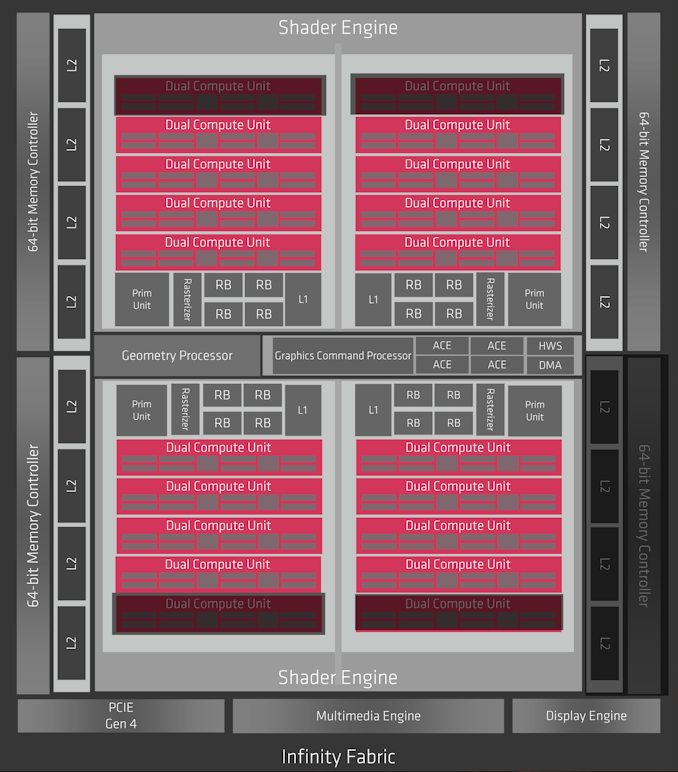
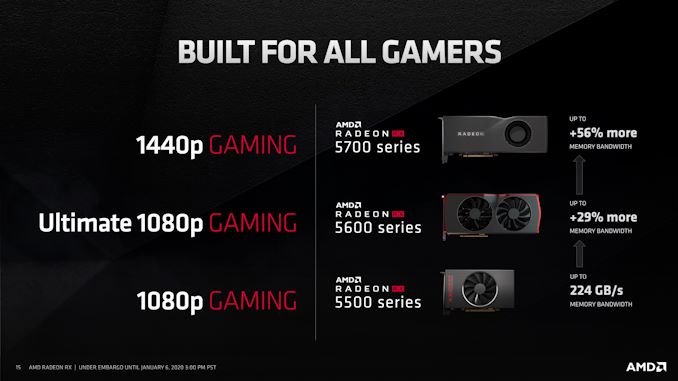
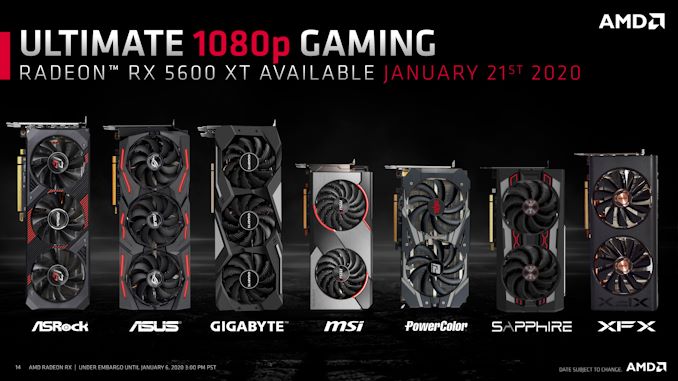
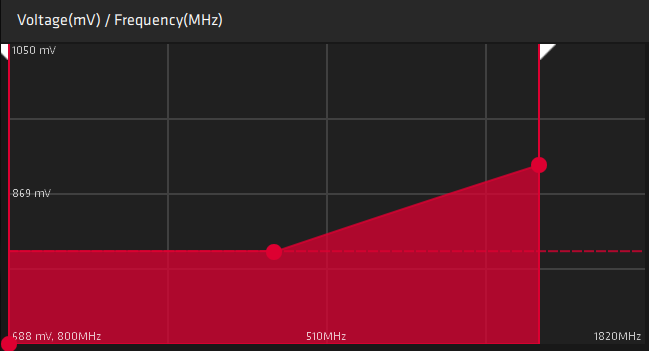
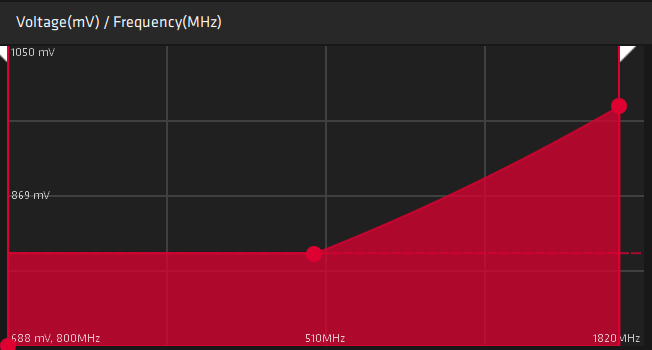

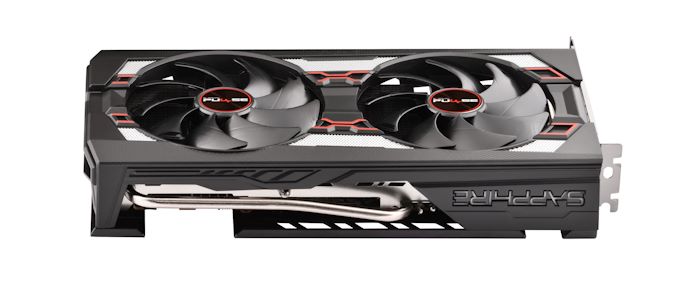
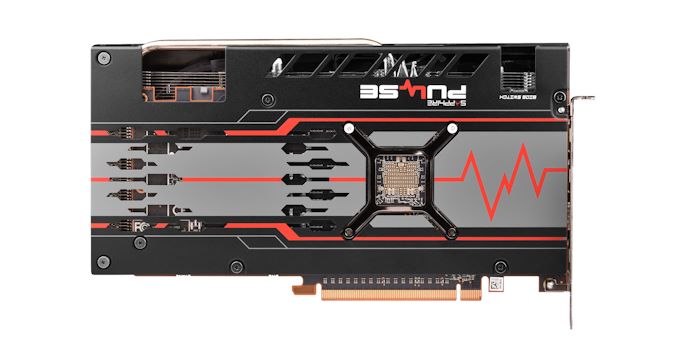
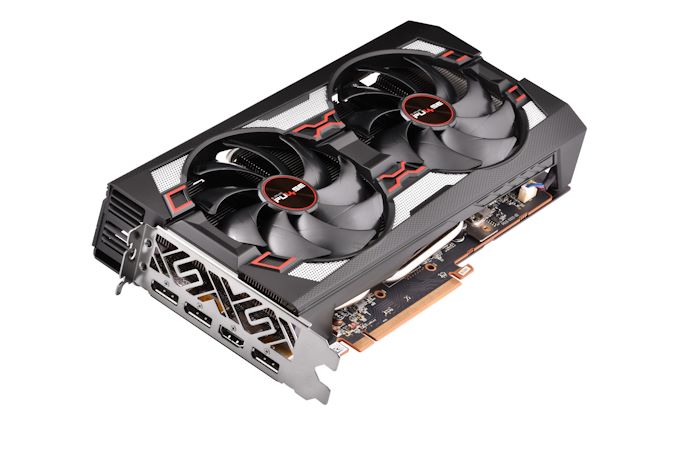

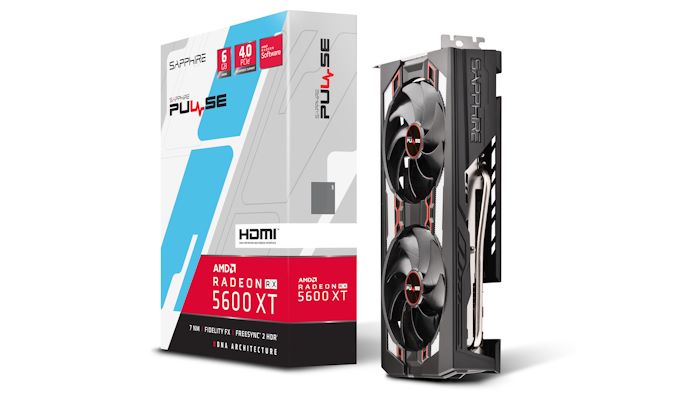
Tidak ada komentar:
Posting Komentar